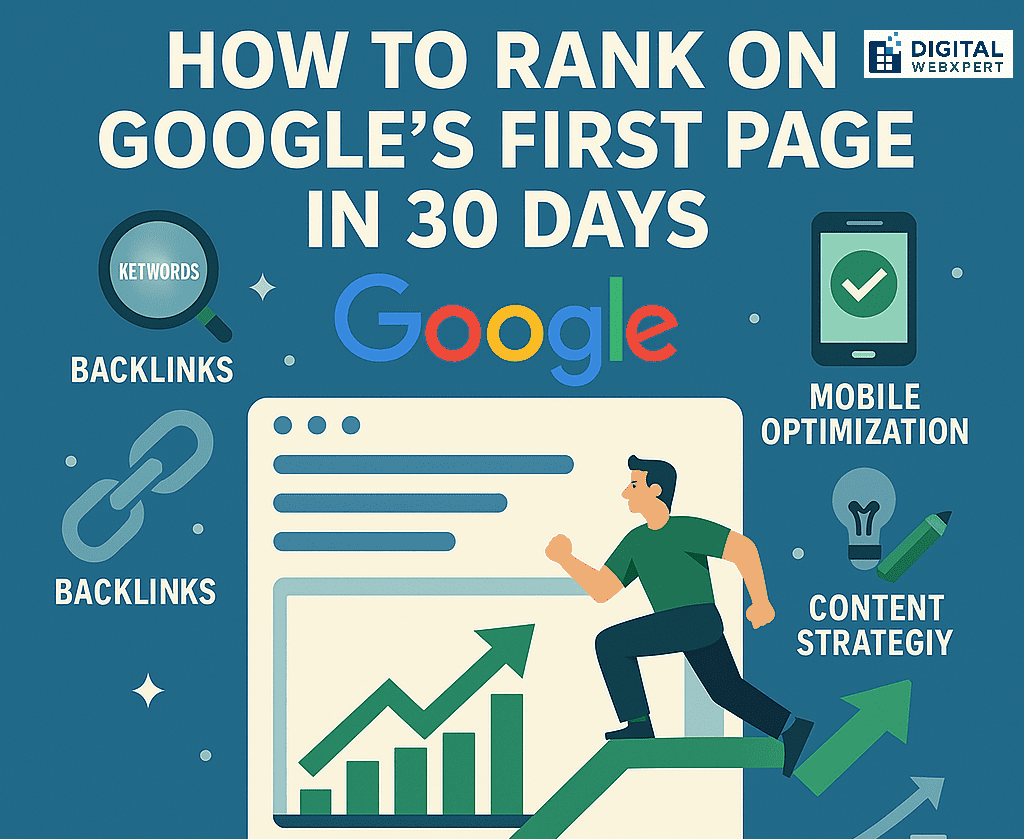If you want to grow your website traffic and authority, ranking on Google’s first page is non-negotiable. The first 10 results receive over 90% of all clicks, and anything beyond page one is virtually invisible.
In this 2025 SEO guide, we’ll show you exactly how to rank on Google’s first page in 30 days—without shady hacks or expensive tools.
Whether you’re a business owner, blogger, or digital marketer, the strategies below are practical, proven, and designed to get results fast.
✅ Step 1: Start with the Right Keywords (High Intent + Low Competition)
If your keywords are too competitive or vague, you’ll struggle to rank—no matter how good your content is.
How to choose winning keywords:
-
Use tools like Google Keyword Planner, Ubersuggest, or SEMrush
-
Focus on long-tail keywords with 500–1,500 monthly searches
-
Choose commercial or transactional intent keywords (e.g., “best SEO agency in Kolkata”)
📌 Example: Instead of targeting “SEO,” try “how to rank on Google’s first page in 30 days” (our focus keyword).
✅ Step 2: Create a High-Quality, SEO-Optimized Page
Google doesn’t rank websites. It ranks pages that provide value.
Here’s how to create a page that ranks:
-
Include your focus keyword in the title, URL, meta description, and H1
-
Add the keyword within the first 100 words and throughout the content naturally
-
Use LSI (related) keywords like: “Google ranking tips,” “SEO strategy,” “on-page SEO,” etc.
-
Structure content with clear H2s and bullet points
-
Use internal links to other valuable content on your site
-
Add outbound links to authoritative sites (Moz, Google Search Central, etc.)
💡 Pro Tip: Write 2,000+ word blog posts—they consistently outrank shorter content.
✅ Step 3: Make Your Page Mobile-Friendly and Lightning-Fast
In 2025, mobile-first indexing means Google primarily uses the mobile version of your site to determine rankings.
Optimize for mobile:
-
Use a responsive theme
-
Keep paragraphs short and font size readable
-
Ensure CTAs (buttons, forms) are easy to click
-
Test using Google’s Mobile-Friendly Test
For speed:
-
Compress images with tools like TinyPNG
-
Use lazy loading
-
Enable caching and use a CDN (Cloudflare is free)
🔍 Faster websites = lower bounce rate = better rankings.
✅ Step 4: Create Engaging, Click-Worthy Meta Titles & Descriptions
Even if you rank, people won’t click if your title tag and meta description are boring.
Best practices:
-
Include your focus keyword in both
-
Keep title under 60 characters, description under 155
-
Use power words like “Proven,” “Ultimate,” “Step-by-Step”
-
Add urgency or numbers (e.g., “in 30 days,” “Top 7,” “2025 Guide”)
Example:
SEO Title: How to Rank on Google’s First Page in 30 Days – Fast SEO Tips for 2025
Meta Description: Want to rank fast on Google? Discover proven SEO strategies that get you on the first page in just 30 days—no hacks, just results.
✅ Step 5: Build High-Quality Backlinks (Not Quantity—Quality)
Backlinks are one of the top 3 Google ranking factors. You need links from relevant, authoritative websites.
Here’s how to get them:
-
Write guest posts on niche blogs
-
Share content on LinkedIn, Twitter, and niche forums
-
Submit your site to local directories and industry listings
-
Use HARO (Help A Reporter Out) to get featured in media
-
Reach out to bloggers and offer to update or contribute to outdated posts
🎯 Aim for 5–10 high-quality backlinks in the first 30 days.
✅ Step 6: Improve Dwell Time & Reduce Bounce Rate
Dwell time = how long users stay on your page. If they bounce quickly, Google assumes your content isn’t valuable.
Increase dwell time by:
-
Adding a video or explainer at the top of the post
-
Using strong introductions that hook the reader
-
Breaking up content with images, bullet points, and quotes
-
Embedding interactive elements like quizzes, tools, or calculators
📊 Bonus: Install tools like Hotjar or Microsoft Clarity to track user behavior.
✅ Step 7: Promote Your Content Immediately (Don’t Wait)
Publishing a great blog is just the beginning. You need eyeballs—fast.
Quick promotion ideas:
-
Share on all your social media channels with a graphic
-
Email your subscriber list with a teaser and link
-
Repurpose the blog into an infographic for Pinterest
-
Post highlights on LinkedIn and tag relevant people
-
Answer related questions on Quora and Reddit with a link back
💡 Google notices traffic spikes and engagement early—this can accelerate indexing and ranking.
✅ Step 8: Monitor Performance and Make Fast Adjustments
Use Google Search Console to track your keyword positions, clicks, and impressions. You’ll learn:
-
What keywords you’re showing up for
-
Which pages are gaining traction
-
Which articles need improvement
If after 15–20 days your post isn’t gaining impressions:
-
Update your title for higher CTR
-
Add internal/external links
-
Repost the content with a fresh twist
-
Consider building more backlinks to the page
🔁 SEO is a test, track, tweak game.
📋 30-Day Action Plan to Rank on Google’s First Page
| Day | Task |
|---|---|
| 1–2 | Keyword research + competitor analysis |
| 3–6 | Create 1500–2000 word SEO-optimized content |
| 7–8 | Design images + build internal links |
| 9–10 | Publish + submit to Search Console |
| 11–15 | Share on socials, email list, forums |
| 16–20 | Begin link building (guest posts, outreach) |
| 21–25 | Update title/meta based on CTR |
| 26–30 | Track performance, tweak for results |
🧠 Final Thoughts
Ranking on the first page of Google isn’t magic. It’s a combination of strategy, content, technical setup, and promotion.
By following this action plan, you’ll understand how to rank on Google’s first page in 30 days, even in competitive niches.
🚀 Need help implementing this SEO strategy? At Digital WebXpert, we specialize in fast SEO wins for small businesses and startups.
👉 Contact us today for a free consultation or on-page SEO audit.

